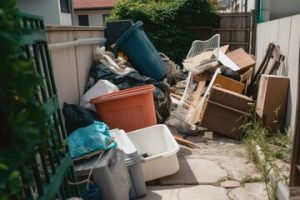Oregon Junk Removal Services are a useful resource for those with cluttered spaces. They help clear out junk and debris from homes, offices, or industrial properties, providing a safe and efficient way to manage waste.

Reputable junk removal companies prioritize eco-friendly practices and donate usable items to local charities. They also take recyclable materials to specialized recycling centers.
Junk removal services are a great way to get rid of unwanted items and declutter your space. These services can help you sort through your junk and properly dispose of it, ensuring that it does not end up in the landfill. They also provide a convenient and affordable way to remove large amounts of junk at once. They can be especially useful if you are preparing for a move or home renovation.
Junk hauling companies offer a full-service option that includes both the pickup and disposal of your junk. They will send 2-3 people to your location who will remove all of your unwanted items from the space and load them into their truck or dumpster. The service will then transport the junk to a local dump or recycling center. They can also donate or recycle items when possible, which helps the environment and community.
Residential junk removal services can be used for a variety of reasons, including spring cleaning, organizing garages and basements, or getting rid of old furniture. They can also be helpful for foreclosure cleanouts, when real estate agents or bankers need to clear out an empty property. They can also help with cleaning up after a pet’s death, when a home needs to be cleaned up and the belongings disposed of.
The most common type of junk removed by residential junk removal services is furniture, appliances, and household items. These items are typically too large or heavy to fit into trash cans and often require special handling. For example, old TVs and couches may contain chemicals that are hazardous to the environment and should not be thrown away. In addition, some junk removal companies specialize in cleaning up messes that result from accidents or crime scenes, such as biohazard cleanup and hoarding cleanup. These services are usually a bit more expensive than standard junk removal, but they can save you time and money in the long run. They can also help to make your space feel more spacious and inviting. They can help you reclaim your home and get it back to its original state.
Commercial
Commercial junk removal services are a valuable asset to businesses of all sizes. They help to clear out space and reduce clutter, allowing employees to focus on their work without distraction. They also help to create a clean and organized environment that enhances customer experience and satisfaction. Whether it’s an office cleanup, retail refresh, or warehouse purge, junk removal services can make all the difference.
When choosing a junk removal service, it’s important to choose one that understands the unique needs of commercial clients. Look for a company that offers flexible scheduling and can accommodate recurring pickups as needed. Also, make sure that the company follows all necessary safety protocols when handling hazardous materials and electronics. In addition, it’s a good idea to select a company that recycles whenever possible and avoids sending items straight to landfills.
Cluttered spaces are a real headache for business owners, hindering productivity and creating a drab and uninviting atmosphere. Junk removal services can help to clear out unused furniture and equipment, making room for more productive activities and additional storage. This can be especially helpful for retail businesses, which often have limited space and must maximize every square foot.
Professional junk removal services also provide a safe and environmentally responsible alternative to traditional trash disposal methods. They take care to properly label items and sort them for recycling or reuse, avoiding the risk of harmful chemicals and metals polluting the environment. It’s a great way for businesses to protect the local ecosystem and reduce their environmental footprint.
A professional junk removal service can save businesses a significant amount of time and money by eliminating the need to handle waste management internally. This allows companies to concentrate on marketing, client services, and other critical aspects of their business. Additionally, junk removal services can help to minimize costly errors and prevent expensive fines by adhering to all relevant laws and regulations.
In the busy world of commerce, a company’s image is everything. A cluttered and unkempt workspace can leave customers with a negative impression, leading to reduced sales and brand loyalty. Junk removal services can help to create a clean and inviting workplace that enhances the customer experience and overall reputation of the company.
Specialized
Junk removal services offer full-service junk disposal for residential and commercial clients. Some specialize in heavy junk, including machinery and equipment, as well as hazardous waste. These types of junk require special handling to prevent environmental contamination.
Many junk removal services have adopted green waste management practices, which minimize landfill waste and contribute to a healthier planet. They also focus on recycling and donating usable items to reduce the amount of waste sent to landfills. They may also provide eco-friendly attic and basement cleanouts, working with estate executors to organize and safely remove items from cluttered spaces.
Other specialized junk removal services include property cleanouts, assisting real estate agents and landlords to clear out vacant space for new tenants. They can schedule same-day or next-day appointments to tackle attics, garages, and construction debris. They also work with hoarders to address severe clutter situations and help them reclaim their living spaces.
When choosing a junk removal service, consider their pricing structure and whether they are licensed to handle specific types of junk. Some companies charge by volume, based on the amount of space your trash takes up in their trucks, while others might have set rates for certain items like mattresses and appliances. Some companies also charge by the hour, which is ideal for time-intensive projects.
Before starting your own junk removal business, research the industry and determine how you will differentiate yourself from your competitors. Create a marketing plan and budget out your projected expenses, which can be broken down into fixed and variable costs. Fixed expenses include things that remain the same regardless of how much business you do, such as truck payments, insurance, and licensing fees. Variable costs depend on the size of your operation and the number of jobs, such as fuel, labor, and marketing.
Once you have decided on your pricing model and marketing strategy, you can start building a team of employees to help with the junk removal process. Be sure to hire qualified, reliable people who will treat your clients’ possessions with respect and care. You should also have the right software in place to streamline and manage your business, such as Workiz, the leading field service management platform. Workiz helps you manage your entire business, from scheduling and dispatching to invoicing and tracking performance. Book a demo of Workiz today to see how it can transform your junk removal business.
Recycling
Junk removal services have become more than just a way to clean up cluttered spaces. By focusing on recycling and donation, these companies help to reduce greenhouse gas emissions, protect natural ecosystems, and save energy by diverting waste from landfills. They also provide safety and health benefits for their employees by preventing strained backs, injuries, and vehicle accidents. In addition, junk removal services can make it easier for businesses to stay in compliance with local laws by removing hazardous materials.
The first step in working with a junk removal service is to contact the company and give them a detailed description of the items you want removed. You may need to provide measurements and images if the items are large or bulky. Providing this information upfront will allow the company to give you a more accurate estimate of the cost. Some companies may even offer an onsite visit, which is especially helpful when dealing with large or heavy items.
Once the junk is collected, it will be taken to a processing center to be sorted. The reusable items will be donated to charities, while the recyclables will go to recycling facilities. Some companies,have their own sorting warehouse where they recycle up to 80% of the items they receive. Other companies, such as Junk King, donate their unwanted items to local charities and offer electronics recycling for their clients.
Junk removal companies are able to take many different types of items, including old furniture, electronics, yard waste, and construction debris. They can also handle large items, such as appliances and office furniture. They can even take hazardous materials, such as paint and batteries, if you have the proper disposal documents. They can even take e-waste, which is illegal to throw away in most states because it contains toxic components that leach into the environment.
Junk removal services can be a valuable resource for both residential and commercial properties. They can help you declutter your space and improve your quality of life by reducing stress, improving focus, and increasing productivity. They can also help you avoid fines by ensuring that your trash is properly disposed of according to local laws. By choosing the right junk removal service, understanding their pricing structures, and comparing DIY options, you can ensure that you get the best value for your money.

